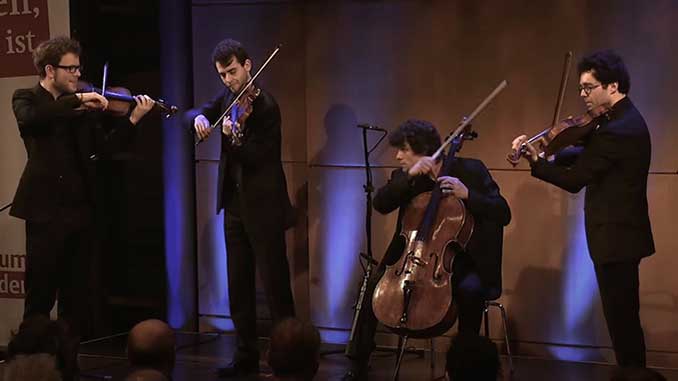 The publicity for the debut Australian tour of the Berlin-based Vision String Quartet made much of the fact that the musicians perform their entire program without printed music. So do jazz musicians! So do rock bands! You might argue. What’s so special about that?
The publicity for the debut Australian tour of the Berlin-based Vision String Quartet made much of the fact that the musicians perform their entire program without printed music. So do jazz musicians! So do rock bands! You might argue. What’s so special about that?
Well, if you were in the audience for this concert, you might have experienced a revelation.
From the moment Florian Willeitner (violin), Daniel Stoll (violin), Sander Stuart (Viola) and Leonard Disselhorst (Cello), who make up the Vision String Quartet, took the stage; their confident, friendly demeanour conjured up the thought that this was a chamber-music version of El Divo – the multi-national classical vocal cross-over quartet.
Usually the goal for classical ensembles is to interpret the written music as close to the composer’s intention as possible, paying particular attention to the composer’s notations regarding tempi, expression, mood and balance.
Vision String Quartet certainly do all that, but by abandoning the necessity to follow the written instructions, the four young virtuosi have discovered the freedom to turn their entire attention to responding to the composer’s music and drawing on each other’s individual skills to create their own unique interpretations of the composers intentions. For their audiences, sharing those discoveries makes for a thrilling experience.
To introduce themselves to Australian audiences, the quartet chose a demanding program of works by Bloch, Bartok and Dvorak.
The Prelude, B.63 composed in 1925 by Swiss-born composer Ernest Bloch proved the perfect introduction. A short 5- minute work, its gentle slow introduction introduced each instrument separately and set the tone and style for the rest of concert.
Following the prelude, violinist Florian Willeitner briefly acknowledged the warm welcome offered by the audience, and the ensemble launched into Bartok’s testing String Quartet No. 4 in C Major.
Who would have thought Bartok could be so much fun? What a revelation for those of us who associate Bartok with discordance and cacophony! Certainly the discordance was there, but in the hands of these musicians it suddenly made sense and became captivating.
Each musician’s obvious mastery of their instrument, together with their absorbance in exploring the possibilities in the musical detail, was so absorbing that the only sensible response seemed to be to simply indulge and let one’s imagination respond to the musical discoveries being offered.
Therefore Bartok’s second movement, Prestissimo, con sordino, marked to be played extremely quickly with mutes, conjured up a garden swarming with busy bees. (I know! But it’s still spring after all).
During the third movement, Non troppo lento, a long-repressed memory of Danny Kaye’s Tubby the Tuba emerged, prompted when the cello launched into a haunting solo while the other instruments hummed admiringly in the background before breaking into excited chatter. (Again, I know! but in defence I’ll paraphrase Noel Coward’s excuse “Strange how potent good music is”).
Of course the audience broke into excited applause between movements – who could blame them – which the musicians acknowledged with encouraging smiles.
Following interval the rest of the concert was devoted to Dvorak’s String Quartet No.13 in G major, Op.106. This work provided a complete change of style and mood with its lush opening which kept promising to break into a Viennese waltz, but of course never did.
As before, the complexities inherent in the music appeared to offer little challenge to the musicians who luxuriated in the opportunities it offered their quest to explore and expose new insights.
This was a recital full of surprises. If there had been an expectation that it would be avant-garde, this was quickly dispelled by the obvious respect and fascination exhibited by the musicians for the music they were presenting, and their colleagues. Their attention to detailing with bowing, musical phrasing, dynamics and execution was mesmerising.
The way they held the moment after each movement, engaged with each other while tossing around musical phrases, and listened intently to blend and mix tone, demonstrated their appreciation of musical etiquette and showmanship. They also understand the value of ambience when presenting their performance. The vast stage of the Llewellyn Hall has seldom looked as elegant or welcoming as it did for this concert.
A warmly- lit, semi-circular screen, flanked by a huge spot-lit arrangement of Australian native flowers, with the rest of the stage flooded in gentle wisteria-coloured wash, created a lovely stage-picture on which to rest eyes, while at the same time, providing an intimate performing space for the musicians.
All of which added immeasurably to the enjoyment of this dazzling ensemble.
Vision String Quartet
Llewellyn Hall, William Herbert Place, Canberra
Performance: Thursday 5 October 2023
The Vision String Quartet will also play City Recital Hall, Sydney (7 & 9 October), Melbourne Recital Centre (10 October) and Adelaide Town Hall (12 October). For more information, visit: www.musicaviva.com.au for details.
Image: Vision String Quartet (supplied)
Review: Bill Stephens OAM
